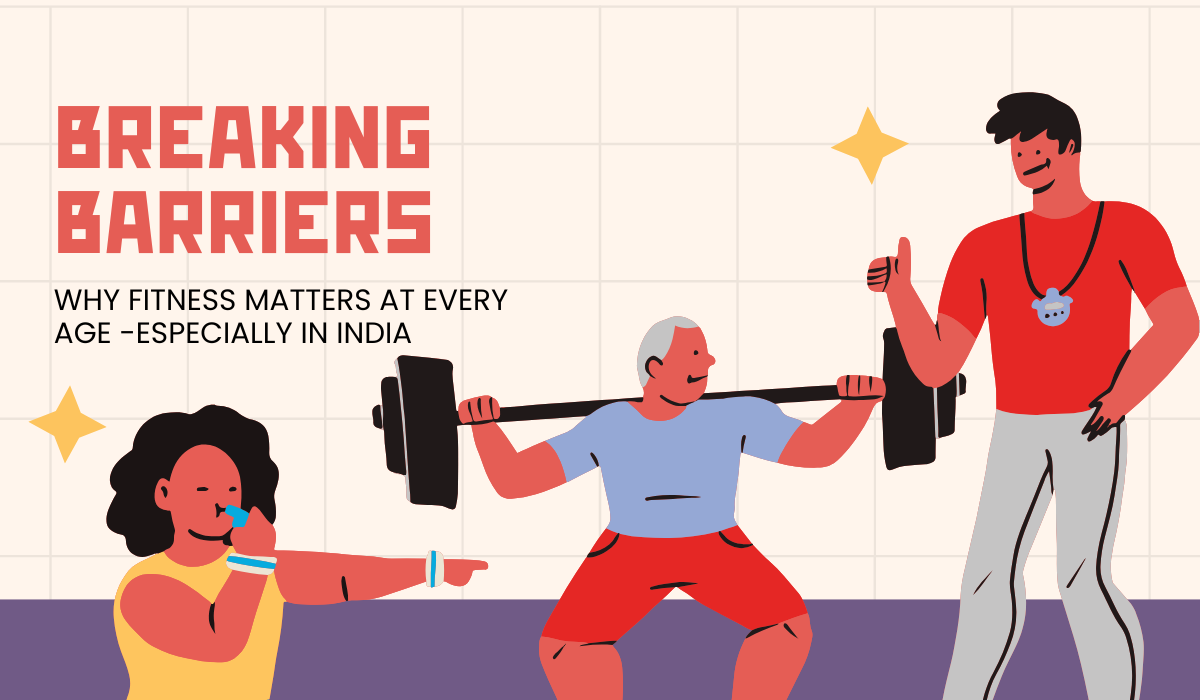Despite growing awareness, in India, fitness discourse is still often limited to the young. Many older adults believe that physical well‑being ends at a brisk morning walk. Such beliefs “I’m too old,” or “I’m too busy” not only limit access to movement, but enforce a mindset that fitness isn’t meant for them. But modern research paints a different story.
Why All Movement Counts
- National and global health guidelines confirm that any amount of movement be it walking, gardening, or stair climbing delivers measurable health benefits. It lowers risks for heart disease, diabetes, mental health challenges, and mortality.
- Strength training and even light resistance work two to three times per week reverses sarcopenia (age-related muscle loss), improves balance, reduces fall risk, and maintains functional independence.
Debunking Age Myths: You Can Get Stronger After 40, 50, or Even Older
- Multiple studies show that younger age is not required to build strength or muscle even people in their 60s, 70s, and 80s make significant gains in strength, bone density, and mobility with properly supervised resistance training.
- A recent Brazilian RCT found that heavy resistance training in retirement-age adults produced muscle-strength gains that persisted over four years.
- Strength routines also boost cognitive function: a UNICAMP study showed improved memory and brain structure in older adults with mild cognitive impairment following six months of resistance training.
- Cardiologist Eric Topol’s study of “super-agers” (80+) confirmed that regular resistance training reduces mortality risk by 10–20%, strengthens bones, improves balance, and combats mental decline.
Fitness in India: Young Minds Focus on Aesthetics — Older Minds Avoid It
- A 2023 Indian study revealed that body esteem among young gym-goers is strongly tied to notions of upper-body strength and physical condition, especially in men reflecting a sociocultural pressure toward idealized physique.
- Yet, older Indians often view exercise as unnecessary or risky believing morning walks are sufficient. A study of Asian Indian seniors in the U.S. shows that while many desire health via activity, perceived risk, health issues, and cultural expectations limit participation.
- Ageism and fitness stigma the idea that older bodies aren’t meant for exercise further discourages movement among seniors.
Why Gyms Should Be About More Than Just Buff Bodies
- Fitness centers now function as rehabilitation hubs: from injury recovery to chronic condition management, tailored programs help users regain mobility, strength, and confidence.
- Movement isn’t just aesthetic, it’s functional: improving posture, joint health, hormonal regulation (e.g. insulin sensitivity, thyroid balance, PCOS), mental well-being, and sustainable weight management.
- It’s not just about six packs. The real goal is a balanced body: good cardiovascular fitness, strong movement capability, stable hormones, mental clarity, and comfort in one’s own skin.
What Real, Whole-Body Fitness Looks Like
| Component | Why It Matters |
| Aerobic (walking, cycling) | Boosts heart health, lung capacity, mood, and endurance. |
| Strength / Resistance | Preserves muscle, prevents falls, improves posture, slows sarcopenia. |
| Mobility / Flexibility | Keeps joints nimble, reduces aches, supports balance and movement fluidity. |
| Postural strengthening | Counteracts sedentary habits, alleviates back and neck pain. |
| Mental health & hormone support | Exercise lowers anxiety, balances mood, improves hormonal health. Stronger bodies feel happier. |
Practical Tips to Begin — At Any Age, Any Schedule
- Start small, stay consistent. Even 15‑minute routines, squats, resistance-band sets, and walks can make a difference. Squats, in particular, have proven anti-aging benefits.
- Progress gradually. Use progressive overload: gradually increase resistance, volume, or reps to stimulate adaptation and strength.
- Prioritize form and recovery. For older beginners, light resistance with attention to technique, rest days, and professional guidance is safer and more sustainable.
- Mix cardio, strength, and mobility. A simple weekly plan: 2–3 resistance sessions (light weights or bands), 3 aerobic bursts, daily stretches or postural exercises.
- Shift your mindset. Fitness is not a one-time goal but a lifestyle. Exercise for function not for eyes. The aim is longevity, joy in movement, and feeling strong in everyday life.
The Takeaway
In India, the stigma that fitness belongs only to youth not to busy professionals or older adults is both outdated and harmful. Research confirms that people of every age can significantly benefit from movement from improved brain health and hormone balance to preserve mobility and independence.
Gyms, parks, and even your living room can offer more than vanity workouts. With intention and evidence-backed practices you can transform your health, mindset, and life. It’s not too late. It’s just time.
SOURCES:
https://en.wikipedia.org/wiki/Sarcopenia?
10 Must-Know Fitness Tips of 2025—All Backed by Science
12 months of heavy resistance training around retirement may have long-lasting benefits
Resistance training – health benefits | Better Health Channel
Exercise Behaviour and Body Esteem of Gym-Goers in India – PMC
Physical Activity in Older Asian Indians Living in the United States | Request PDF
Ageism in the Fitness and Health Industry: A Review of the Literature



